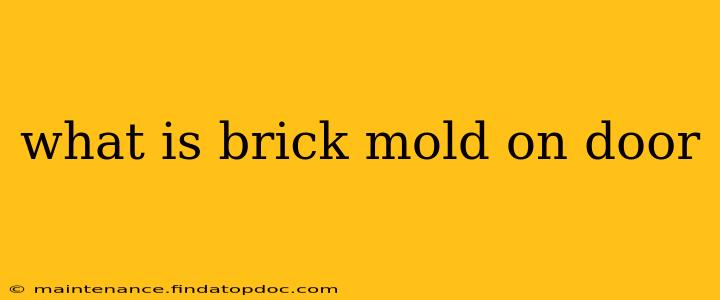Brick mold, also sometimes called door brickmould, is a decorative trim piece that covers the gap between a door frame and the surrounding brick or masonry. It's more than just aesthetics; it serves crucial practical functions, protecting the door and improving the overall appearance of your home's exterior. This comprehensive guide will delve into everything you need to know about brick mold, answering common questions and exploring its various aspects.
What is the Purpose of Brick Mold?
Brick mold serves several vital purposes:
- Protection: It shields the door frame from the elements, preventing water damage, rot, and insect infestation. The brick mold acts as a barrier, keeping moisture from seeping into the wood, extending the life of your door and frame.
- Aesthetic Enhancement: Brick mold significantly improves the curb appeal of your home. It provides a clean, finished look, creating a visually appealing transition between the door and the brickwork. Various styles and materials allow for customization to complement your home's architecture.
- Structural Support: While not its primary function, brick mold can offer a degree of structural support to the door frame, especially in older buildings.
- Insulation: Depending on the material and installation, brick mold can contribute a small amount to the overall insulation of your home by creating a tighter seal around the door frame.
What are the Different Types of Brick Mold?
Brick mold comes in various materials, styles, and profiles, allowing for a wide range of design options:
- Material: Common materials include wood (often primed or pre-painted), vinyl, aluminum, and fiber cement. Wood offers a classic look and can be painted to match your home's style, while vinyl is low-maintenance and durable. Aluminum is a robust option, particularly resistant to damage, while fiber cement provides a strong and weather-resistant alternative.
- Style: Styles range from simple, straight profiles to ornate, decorative designs. The choice depends on your personal preference and architectural style.
- Profile: The profile refers to the shape of the molding. There are numerous profiles available, from simple flat pieces to more intricate designs with curves and bevels.
What are the Benefits of Using Brick Mold?
The benefits of installing brick mold extend beyond the purely aesthetic:
- Increased Home Value: A well-maintained exterior, including proper brick mold, can significantly increase your home's value.
- Protection from the Elements: As mentioned previously, it protects the door frame from water damage and decay.
- Improved Energy Efficiency: While not a primary function, it can contribute to better insulation.
- Enhanced Curb Appeal: A stylish and well-installed brick mold instantly upgrades your home's exterior appearance.
How is Brick Mold Installed?
Brick mold installation varies slightly depending on the material and style, but generally involves:
- Measurement and Cutting: Accurate measurements are crucial for a proper fit.
- Preparation: The area around the door frame needs to be clean and prepared for installation.
- Attachment: The brick mold is attached to the door frame using nails, screws, or adhesive, depending on the material. Proper sealing is essential to prevent water infiltration.
- Caulking: Caulking around the edges ensures a weathertight seal.
Professional installation is often recommended, especially for complex designs or materials.
How Much Does Brick Mold Cost?
The cost of brick mold varies depending on the material, style, size, and whether you hire a professional for installation. Expect to pay anywhere from a few dollars per linear foot for basic vinyl to several dollars per linear foot for high-end wood or custom designs. Labor costs for professional installation can significantly add to the overall expense.
How Do I Choose the Right Brick Mold for My Home?
Choosing the right brick mold involves considering several factors:
- Architectural Style: Select a style that complements your home's overall design.
- Material: Consider durability, maintenance requirements, and budget.
- Color: Choose a color that coordinates with your home's exterior paint and brickwork.
- Profile: Select a profile that enhances the aesthetics of your door without being overly ornate or clashing with the surrounding elements.
By carefully considering these factors, you can choose brick mold that perfectly complements your home and provides years of protection and beauty. Investing in high-quality brick mold is an investment in the longevity and curb appeal of your property.
